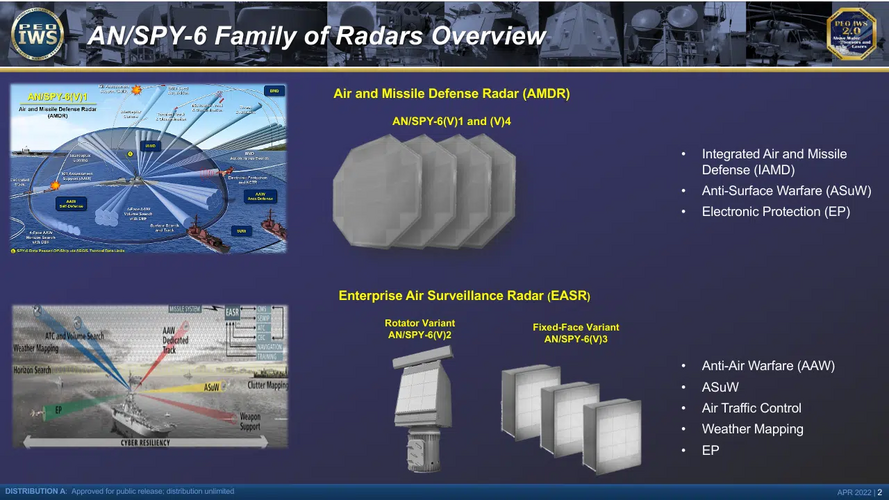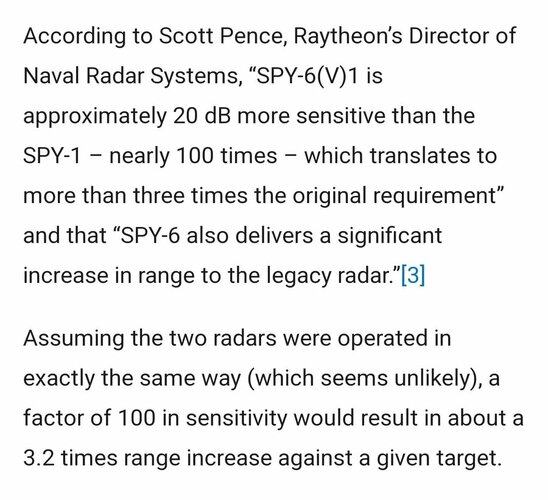Forest Green
ACCESS: Above Top Secret
- Joined
- 11 June 2019
- Messages
- 9,412
- Reaction score
- 17,142
the latest aegis baseline, see my twitterAn interesting little graphic about the evolution of Aegis specs from the earliest baselines up to BL 10 (the baseline used by the AMDR-equipped Flight III DDGs).


The DOT&E documents makes it seem like the new baseline definitions for BL 9.Cx corresponds to 9.2.x for example, though I'm not sure if that's correct.the latest aegis baseline, see my twitter
The U.S. Navy is putting the radar on all new destroyers, as well as aircraft carriers, amphibious ships and frigates – every class of ship. Some of the work is already underway at the Huntington Ingalls Industries, or HII, shipyard in Pascagoula, Mississippi, where Raytheon is integrating:
Work has started at other shipyards, where the company is integrating:
- SPY-6 (V)2 onto the future USS Richard M. McCool (LPD 29) and has completed the first sea trial.
- SPY-6 (V)1 onto the future USS Ted Stevens (DDG 128).
- SPY-6 (V)2 onto the future USS Bougainville (LHA 8).
- SPY-6 (V)3 onto the future USS John F. Kennedy (CVN 79) at HII in Newport News, Virginia.
- SPY-6 (V)3 onto the future USS Constellation (FFG 62) at Fincantieri Marinette Marine in Marinette, Wisconsin.
Right now TKMS Meko 400 Looks like the fastest solution.... building would start in Germany 2025
BL 9C originally represented the Burke-class BL 9.The DOT&E documents makes it seem like the new baseline definitions for BL 9.Cx corresponds to 9.2.x for example, though I'm not sure if that's correct.
I'd just as soon go for the full 57mm Mk110s as the "small gun", and have some airburst rounds available for busting small boats.The next cruiser design I really hope they incorporate a second deck gun and multiple 30 mm guns both port and starboard
As I understand AESAs, each TRM has a receiver.(...)
The Raytheon SPY-6 is a scalable radar built up with individual RMAs, radar modular assembly, two-foot by two-foot by two-foot radar that works as a radar itself, each RMA contains 24 TRMs, would i be right in thinking it has one receiver per 24 TRM/RMA???
My impression maybe is part of the DARPA Technologies for Heat Removal in Electronics at the Device Scale, THREADS, program. Contracts have been placed with Raytheon, Northrop Grumman, BAES and Qorvo to develop improved gallium nitride (GaN) power amplifiers by both reducing the thermal resistance within the device and moving the heat away from high power transistors more efficiently either to increase the RF performance from same size array panel or improve the MTBF while able to maintain a channel temperature below the nominal maximum operating temperature of 225 degrees Celsius approx. 440 degrees Fahrenheit.



When we're talking about electrical units like voltage, current, and power, it's pretty easy to remember which units use the 10log equation and which use 20log: any units related to power use 10log and the rest use 20log. However, with other units, like sound pressure level, it's not quite as obvious. Below is a list of common units and whether they use 10log or 20log when using decibel units. Also note that any units that use 10log are increased 3dB per doubling, whereas any units that use 20log are increased 6dB per doubling.
Yeah with DDG-138Are Burke Flt 3 receiving SEWIPS blk3 at some point? The first ship lacks it.


If the 24 RMA (V)4 is +15dB (32x), then how much is the 37 RMA (V)1? 50x?
 https://www.military.com/daily-news...sthand-look-navys-new-spy-6-radar-system.html
https://www.military.com/daily-news...sthand-look-navys-new-spy-6-radar-system.htmlAnd that's with access to whatever temperature the outside ocean water is at for an additional heat sink... (Of course, I got spoiled with access to 40degF/4degC water basically all the time.)The Burke Flight IIIs had to upgrade their five AC plants to 300 refrigeration tons capacity from the 200 ton units in Flight IIAs needed to cool the new more powerful SPY-6 (V)I GaN radar and the new SEWIP Block III GaN EW system.
Is sensitivity different to power though. Power is output (Tx side), sensitivity is on the Rx side surely? Or maybe 100 is overall seen as it refers to a range increase, which would combine both. But the range estimate seems to be an assumptions of the author based on 100^(0.25), rather than a direct quote.
But as far as i could tell we dont even know how mutch improvement they have in dB. I got for V4 11-15 dB and V1 15-20dB. The 3 times the range is from a high Level Naval dude (i think as i cant remember who he was) which said it was 3x better then the original goal was.
This is the post in question:But as far as i could tell we dont even know how mutch improvement they have in dB. I got for V4 11-15 dB and V1 15-20dB. The 3 times the range is from a high Level Naval dude (i think as i cant remember who he was) which said it was 3x better then the original goal was.
The Air and Missile Defense Radar program set a requirement for the SPY-6(V)1 sensor to be 30 times more sensitive than the SPY-1. The Navy has validated that the new sensor has a decibel measurement of “+20dB” compared to the legacy radar, according to a Raytheon document approved by the Navy for public release.
“SPY-6(V)1 is approximately 20dB more sensitive than SPY-1 -- nearly 100 times -- which translates to more than three times the original requirement,” said Scott Spence, director of naval radar systems, told Inside Defense. “SPY-6 also delivers a significant increase in range to the legacy radar.”
That diagram seems to be confusing the 24 RMA retrofit (V)4 version with the full 37 RMA (V)1 version based on my earlier post:The original goal, in 2000 the Navy established the Surface Navy Radar Roadmap, which among other things called for an increased radar sensitivity to meet the needs for a BMD AMDR with the necessary target discrimination ability so as to be able to distinguish the BM missile warheads from the decoys.
The Navy chose an upgraded 10,000t Burke as the platform for the AMDR instead of the horrendously expensive Zumwalt, the maximum antenna array weight they could safely fit on a Flight III was a 14-foot, whereas to meet the spec it was originally estimated a 20-foot array was needed (a 69 RMA array) how the current 37 RMA 14-foot array SPY-6(V)1 compares to original 20-foot array not sure.
The Japanese with their ASEV destroyers with the SPY-7 have gone to 17,000t to take the necessary large radar array top weight.
Why wanting to have Laser when you got Spy-6 with 69 RMA69 RMA should theoretically be:
10log[(69/24)^3] = +13.8dB
+15dB +13.8dB = +28.8dB
Probably enough to boil the brains of enemy pilots buzzing your ship.
Zumwalt with SPY-6: now you dont need dedicated CIWS anymore!Why wanting to have Laser when you got Spy-6 with 69 RMA
The diagram isn't confusing the versions, it's from 2016 and predates Raytheon proving they surpassed AMDR's performance requirements.That diagram seems to be confusing the 24 RMA retrofit (V)4 version with the full 37 RMA (V)1 version based on my earlier post:
Having looked at the numbers, I think the dB measurements are actually factoring in the gain as well as the power, which is dependent on aperture area. Overall received power is proportional to the Powerx(Gain^2) product and Gain is proportional to area. So the log of the RMA ratio cubed x10 should give the dB increase.
The Radar Equation - Radartutorial
www.radartutorial.eu
So with 24 RMA giving +15db and 37 giving +20db
10log[(37/24)^3] = 5.6.
37 RMA is +5.6dB more than 24 RMA or +20.6dB
69 RMA should theoretically be:
10log[(69/24)^3] = +13.8dB
+15dB +13.8dB = +28.8dB
Probably enough to boil the brains of enemy pilots buzzing your ship.
A 57 RMA array would be very similar in dimensions to a 69 RMA array. Removing 12 RMAs will most likely be achieved from the "diagonal" edges of the octagonal array, meaning width and height of the array are going to be the same as the 69 RMA array.There's also now an intermediate array between 37 and 69 in Navy planning documents. It's 18ft with 57 RMAs, which they are treating as the max able to fit on DDG(X) at ≈ 13,500 tons. Personally, I'd rather they stop faffing about and just design a ship that fits the 69-RMA arrays.
The MDA and USN Feb 8 carried out FTX (Flight Test Other)-23 / Stellar Sisyphus a two part test off the Hawaii coast in which it appears to be test of the new SPY-6 radar and comms with Aegis in which a C-17 launched a MRBM in mid-air that was then shot down, presume with Jack H Lucas as the first and only Flight III Burke commissioned to date with SPY-6.



